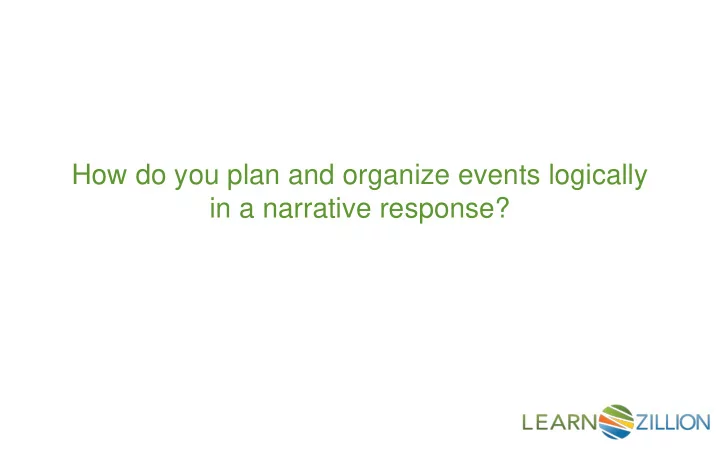

How do you plan and organize events logically in a narrative response?
In this lesson you will learn how to plan and organize logical events in a narrative reading response by analyzing the way a mentor author establishes a beginning, middle and end.
Let’s Review Write a poem in response to Emily Dickinson’s “The Wind’s Visit”, where the narrator is the wind. Your poem should describe a second visit between the two characters, from the wind’s point of view. The poem should be brief, like Dickinson’s. Your poem should “pick up” where “The Wind’s Visit” left off and your word choice and description should let the reader know how the wind feels or reacts to this visit. Your poem should describe the visit completely, so that the reader has the sense of conclusion by the poem’s end.
Let’s Review Writing Process 1 2 3 4 Read Generate Draft & Edit & closely & & plan revise publish analyze Write a poem in response to “The Wind’s Visit”, where the wind is the narrator.
“The Wind’s Visit” Let’s Review by Emily Dickinson • Narrator “visited” by the character The Wind’s Visit the wind The wind tapped like a tired man, And like a host, “Come in,” • Poetry has unique structure I boldly answered; entered then My residence within • Like a good story, poems need to A rapid, footless guest, have events that are organized or To offer whom a chair sequenced Were as impossible as hand A sofa to the air. • Also like a story, this sequence of No bone had he to bind him, His speech was like the push events needs to unfold naturally Of numerous humming-birds at once as well as logically From a superior bush.
Core Lesson Reread the text, paying attention to how the 1 author sequenced the events. Ask, “Is there a beginning, middle and end to 2 the series of events?” Jot down the beginning, middle and end. Ask, “Do these events occur in a way that 3 makes sense?” List your numbered plan of events.
Reread the text, paying attention to Core Lesson how the author sequenced the events. The Wind’s Visit How does the author sequence the events? The wind tapped like a tired man, And like a host, “Come in,” I boldly answered; entered then My residence within A rapid, footless guest, To offer whom a chair Were as impossible as hand A sofa to the air. No bone had he to bind him, His speech was like the push Of numerous humming-birds at once From a superior bush.
Reread the text, paying attention Core Lesson to how the author sequenced the events. How does the His countenance a billow, author sequence His fingers, if he pass, the events? Let go a music, as of tunes Blown tremulous in glass. He visited, still flitting; Then, like a timid man, Again he tapped — 't was flurriedly — And I became alone. Emily Dickinson
Ask, “Is there a beginning, middle and Core Lesson end to the series of events?” Jot down the beginning, middle and end. The Wind’s Visit Beginning: The narrator & The wind tapped like a tired man, character (the wind) And like a host, “Come in,” meet I boldly answered; entered then My residence within Middle: A rapid, footless guest, The narrator describes To offer whom a chair the action of the Were as impossible as hand character (the wind) A sofa to the air. No bone had he to bind him, His speech was like the push Of numerous humming-birds at once From a superior bush.
Ask, “Is there a beginning, middle Core Lesson and end to the series of events?” Jot down the beginning, middle and end. Middle (cont.): His countenance a billow, The narrator describes His fingers, if he pass, the action of the character Let go a music, as of tunes (the wind) Blown tremulous in glass. He visited, still flitting; End: Then, like a timid man, Again he tapped — 't was flurriedly — The character (the wind) And I became alone. leaves; narrator left alone Emily Dickinson
Ask, “Do these events occur in a way Core Lesson that makes sense?” List your numbered plan of events. Beginning: 1. The narrator (the wind) The narrator & character (the is waiting for character (woman); they meet wind) meet My plan 2. The narrator (the wind) describes the action of Middle: the character (the The narrator describes the woman) 3. The narrator (the wind) action of the character (the leaves; character (the wind) woman) left alone End: The character (the wind) leaves; narrator left alone
Core Lesson Writing Process 1 2 3 4 Read Generate Edit & closely & Draft & & plan publish analyze revise
Core Lesson Reread the text, paying attention to how the 1 author sequenced the events. Ask, “Is there a beginning, middle and end to the series of events?” Jot down the beginning, 2 middle and end. Ask, “Do these events occur in a way that makes sense?” List your numbered plan of 3 events.
In this lesson you have learned how to plan and organize logical events in a narrative reading response by analyzing the way a mentor author established a beginning, middle and end.
Recommend
More recommend